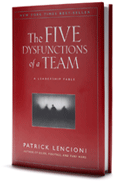 I have played on a competitive volleyball team for the past 15 years. Three of us have been together for the entire time, another two players have been a part of the team for the past 6 or 7 years, and this season we have one new person. For whatever reason, this year we were enjoying some great chemistry as a team. We were playing well and having fun doing it. And then Kyle decided to move to California. It is amazing how the removal of one person can affect the make up of a team; we have struggled to replace him.
I have played on a competitive volleyball team for the past 15 years. Three of us have been together for the entire time, another two players have been a part of the team for the past 6 or 7 years, and this season we have one new person. For whatever reason, this year we were enjoying some great chemistry as a team. We were playing well and having fun doing it. And then Kyle decided to move to California. It is amazing how the removal of one person can affect the make up of a team; we have struggled to replace him.
Over the past couple of months a great deal of my focus has been on providing team building training and there are some parallels between that training and what I have experienced with my volleyball team. Teams can come together and ‘gel’ very quickly, or they can take a great deal of time to get where they want to be. And of course, some never really achieve the level of functioning that they would like to. Every team is different with a variety of strengths and challenges, but there is a distinct competitive advantage for a group of individuals who can find a way to function as a truly great team.
Previously I shared that I am a Patrick Lencioni fan. His book, The Five Dysfunctions Of A Team is one of my favourites and I use it has a template for the training I provide. Lencioni suggests that teamwork is the “ultimate competitive advantage, both because it is so powerful and so rare.” He offers that the components for building a great team are not all that remarkable, in fact the five key components that he lists; trust, good conflict, commitment, accountability, and attention to results, are really rather straightforward and easy to understand. The difficultly comes however in consistently applying them. In Lencioni’s own words, “Like so many other aspects of life, teamwork comes down to mastering a set of behaviors that are at once theoretically uncomplicated, but extremely difficult to put into practice day after day. Success comes only for those groups that overcome the all-too-human behavioural tendencies that corrupt teams and breed dysfunctional politics within them.”
It may take a concerted effort to make it happen, but the majority of people I talk to enjoy being a part of a team that is working well together. Great teams attract great team players. And great team players on great teams achieve more collectively than they could on their own.
This entry was posted
on Thursday, February 24th, 2011 at 11:27 am and is filed under Comments.
You can follow any responses to this entry through the RSS 2.0 feed.
Both comments and pings are currently closed.


Chemistry, Kyle, & California
Over the past couple of months a great deal of my focus has been on providing team building training and there are some parallels between that training and what I have experienced with my volleyball team. Teams can come together and ‘gel’ very quickly, or they can take a great deal of time to get where they want to be. And of course, some never really achieve the level of functioning that they would like to. Every team is different with a variety of strengths and challenges, but there is a distinct competitive advantage for a group of individuals who can find a way to function as a truly great team.
Previously I shared that I am a Patrick Lencioni fan. His book, The Five Dysfunctions Of A Team is one of my favourites and I use it has a template for the training I provide. Lencioni suggests that teamwork is the “ultimate competitive advantage, both because it is so powerful and so rare.” He offers that the components for building a great team are not all that remarkable, in fact the five key components that he lists; trust, good conflict, commitment, accountability, and attention to results, are really rather straightforward and easy to understand. The difficultly comes however in consistently applying them. In Lencioni’s own words, “Like so many other aspects of life, teamwork comes down to mastering a set of behaviors that are at once theoretically uncomplicated, but extremely difficult to put into practice day after day. Success comes only for those groups that overcome the all-too-human behavioural tendencies that corrupt teams and breed dysfunctional politics within them.”
It may take a concerted effort to make it happen, but the majority of people I talk to enjoy being a part of a team that is working well together. Great teams attract great team players. And great team players on great teams achieve more collectively than they could on their own.
This entry was posted on Thursday, February 24th, 2011 at 11:27 am and is filed under Comments. You can follow any responses to this entry through the RSS 2.0 feed. Both comments and pings are currently closed.